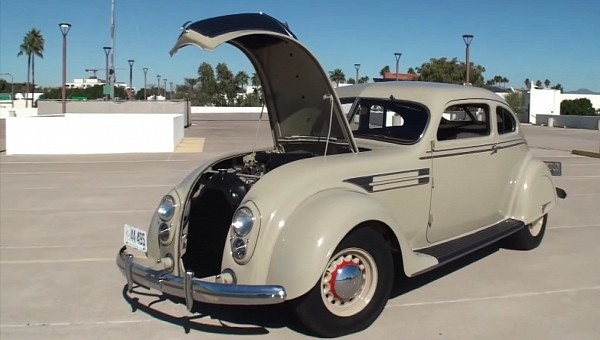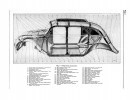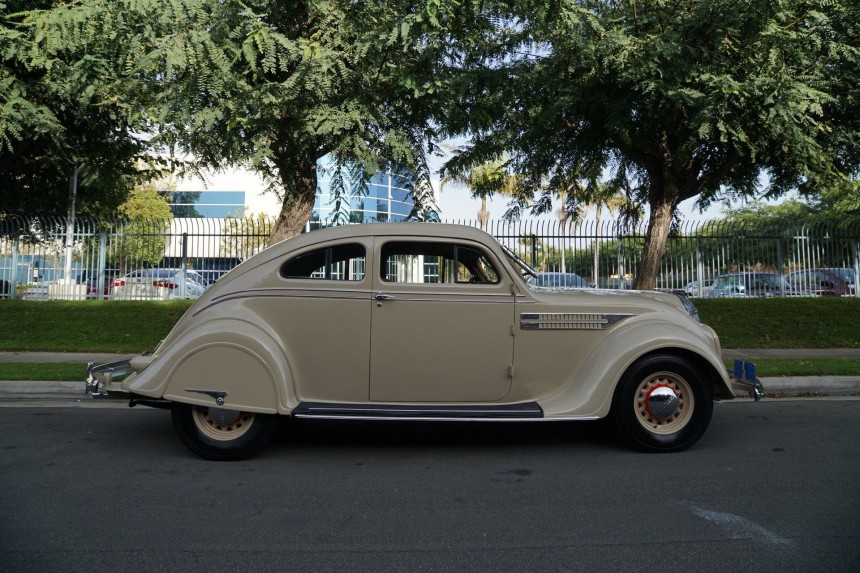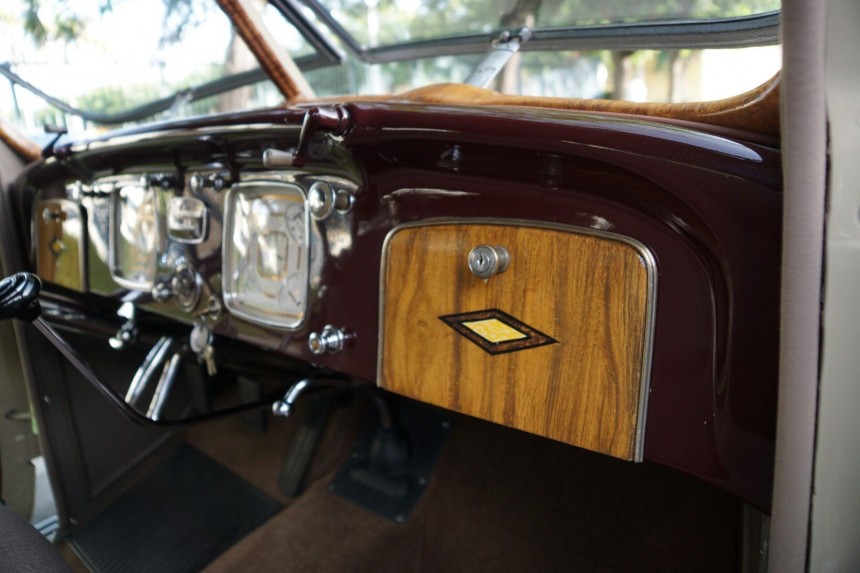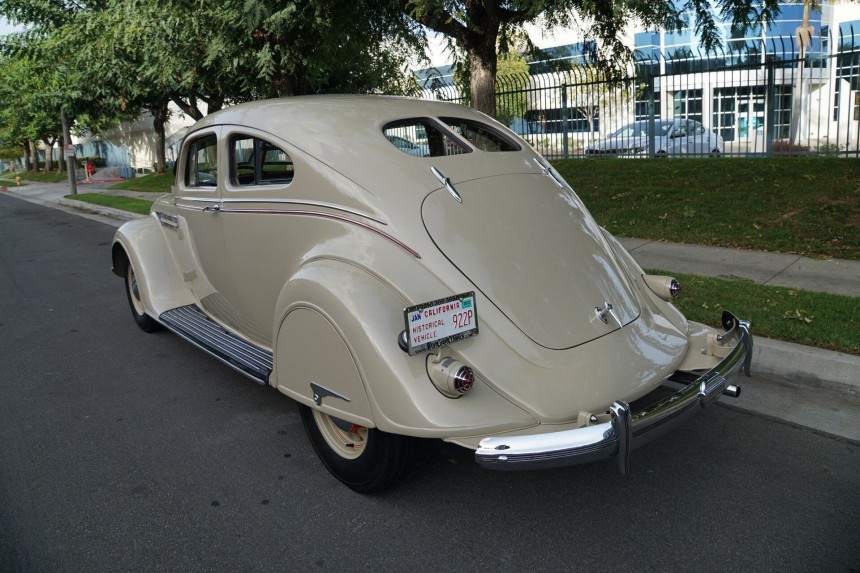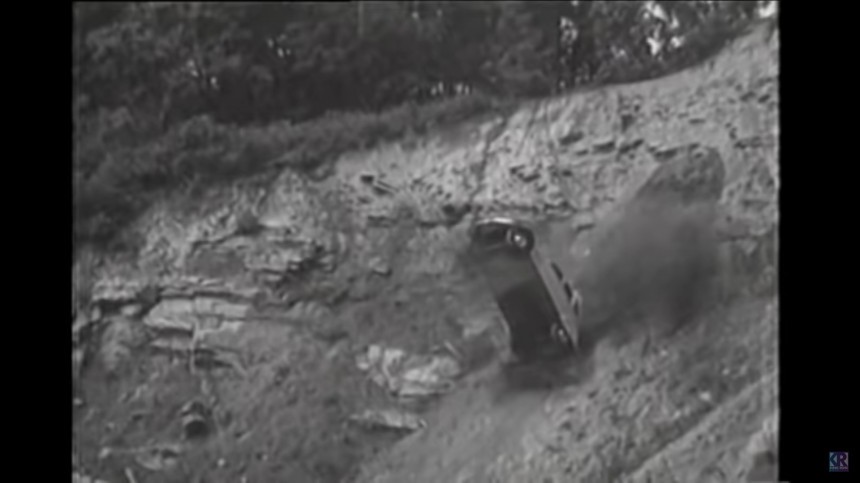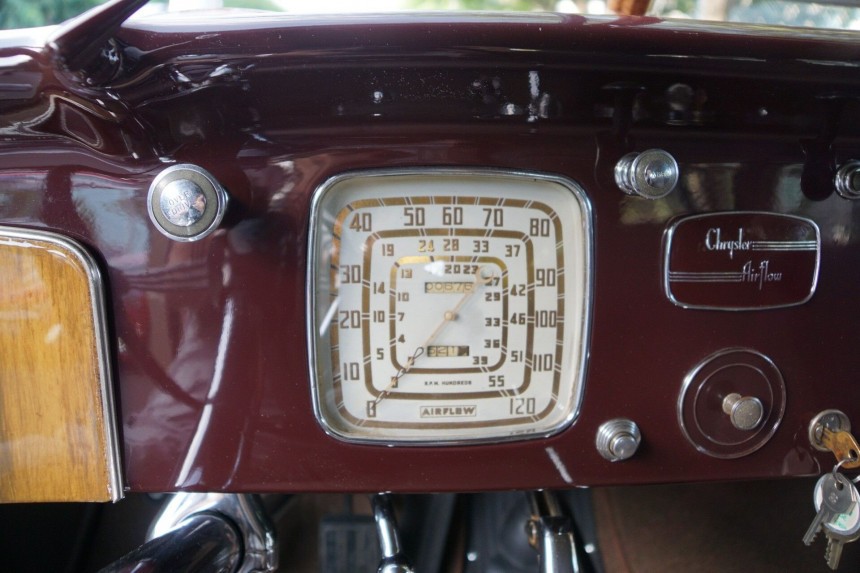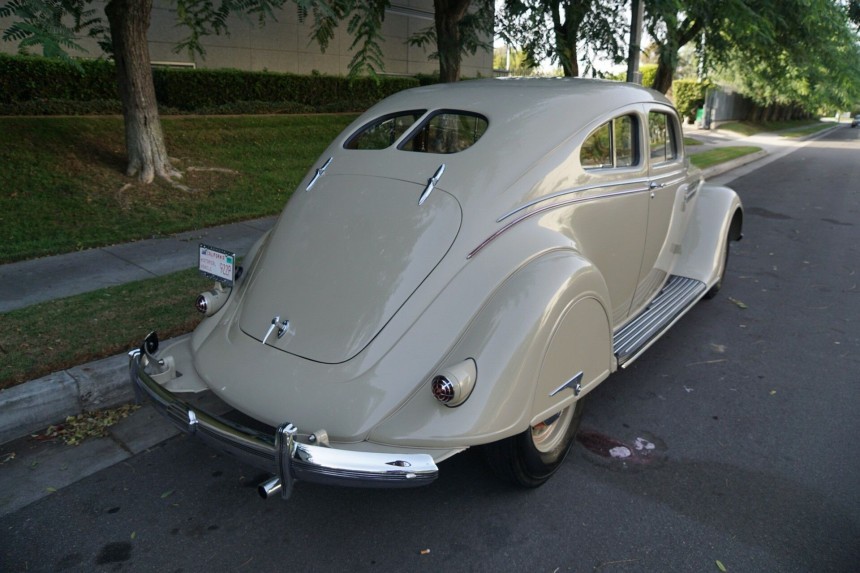Chrysler Corporation made legendary automobiles throughout its 99-year car-building history. Some became monuments of the piston-driven industry, while others fell into undeserved oblivion. One of those cars that ended up on the wrong side of collective gearhead memory is the Airflow or the 30s.
Named in blunt obviousness of its immediately visible characteristic – the aerodynamic shape – the model was nothing short of an engineering breakthrough. It was so different in design that it surprised everyone – including the buying public. The sales figures loomed over the mechanical and aesthetic aspects. The Airflow was assembled only during a three-year-long (failed) automotive revolution.
Built between 1934 and 1937, the smooth-edged Chrysler sedan wasn’t a sales blockbuster, and its coupe variant was even less so. In 1936, for example, only 110 two-door Airflows came out, and six are documented to be around still.
One of them is this sparkling piece of automotive jewelry, the latest feature on a popular YouTube channel. Filmed in January of this year, in Arizona, by Lou Costabile, this particular example has been meticulously restored and is in stellar condition. The current owner purchased the car a year ago via an auction site (the photos in the gallery are from there, too).
The car was styled by the wind – not metaphorically, but practically. Chrysler’s genius engineers built their wind tunnel and studied over 50 scale models of various shapes. With the help of one of the Wright brothers (Orville, to pay the due diligence), the Chrysler Airflow embodied what the corporation dubbed “functional design.”
It was sleek, nimble, elegant, beautiful, spacious, economical, practical, innovative, powerful, and tough. Pretty much like America itself was back then – except it did not yet dare to admit it. The automobile was groundbreaking in several aspects – chief of which would be its looks.
Curves and fluid lines replaced the boxy contours of then-contemporary automotive design. This feature became one of the model’s sales drawbacks. It was almost too advanced, and its demeanor wasn’t to the taste of a motor-conservative public. But it was the build quality that hindered its financial success.
The Airflow was developed with scientific accuracy but built with profit-chasing haste. The bosses from New York wanted the Airflow to be a star at the “Century of Progress International Exposition” in Chicago. It was - and made a great impression – but several manufacturing issues took a heavy toll on the quality of the car, overcoming its brilliant engineering.
Accountants and executives wanted to cash in on the sensation automobile, but engineers would have waited longer. Beans counters had their say, and the car was presented in due time for the corporate birthday, on January 6, 1934, at the New York Auto Show. Had it not been for the haste to launch it for Chrysler’s tenth anniversary, perhaps the Airflow would have been a mature enough project to live long and prosper.
The drivetrain featured several innovations made possible by the car’s shape. How so? The wind-tunnel-conceived aerodynamic vehicle offered the unlikely answer to a very stressful question: how to go faster without an impractically-big engine.
Reducing air resistance (drag) was the obvious choice, translating into a nature-inspired form – the teardrop that became the Airflow. But the never-before-seen contour was only the tip of the advanced technology iceberg. Under the surface laid another equally critical innovation – the steel frame.
Over the years, urban legends have claimed that the Chrysler Airflow pioneered the unibody concept. Not accurate, but close. The construction made the best of both worlds – body-on-frame and unibody. At the seven-minute mark in the first video, a diagram of the car’s underside debunks the unit-body myth.
At the base of the Airflow laid the typical ladder frame. Chrysler’s engineer Carl Breer designed a secondary frame (for the body only) bolted to the standard chassis to create the complete structure. Play the second video – a Chrysler commercial film from 1933 starring baseball players, stunt drivers, and state troopers – to see the concept put to practical work.
The Airflow gained immense media attention in the 30s when it was rolled off – end over end – a 100-foot rock quarry (it is also vividly captured in slow-motion in the promotional film). After the car reached the bottom, a driver climbed in and drove away with only minor sheet metal damage. Even the glass stayed intact, to say nothing of the engine and transmission.
I won’t go down the speculation alley about the verity of that particular act, as there is no way to verify the details. Whether it was a regular Airflow or a modified stunt car is under a massive shadow of a doubt, but it is irrelevant to our story.
In some ways, automobiles from that pre-war era were superior to their present-day successors. Simplicity would be one aspect, practicality could be another, and sturdiness is not to be disregarded.
Look closely at the dash and instrumentation of this Airflow: the main gauge indicates speed, RPM, and RPM, all in one three-scale dial. Not a typo, ladies, and gentlemen – this 1936 Chrysler straight-eight had two operating regimes: regular drive and overdrive. The outermost numbers indicate speed (a very bold 120 mph is the upper limit), and the middle and inner values are the engine’s speed during the two cycles.
About the engine – an inline-eight with 323.5 cubic inches (5.3 liters) sits over the front axle of this old-timer. Not the original block but a factory-correct replacement. So are the correct Stromberg EXV-32 one-barrel carburetor and the “barrel-style” Auto-Lite electric choke.
The cast-iron cylinder heads are just what a brand-new Airflow Coupe would have received on the assembly line in February 1936. Where possible, New Old Stock (NOS) parts were used on the inline-six powerplant, and as we can see and hear, it runs and drives like a dream.
This 1936 Chrysler Airflow Coupe has caught the attention of hard-core fans of the model, who pointed out that the fender welting is the same color as the body. It is not a mistake; it was a one-year-only specific – all the other model years had black fender welting.
The L-head engine was rated at 115 hp and 178 lb-ft when new (117 ps, 242 Nm), thanks to a 6.5:1 compression. Sufficient to rush the three-speed manual to 90 mph (145 kph). That is, if the engine didn’t fall off when the car hit the 80 mph (130 kph). The incident repeatedly occurred in many of the first 3,000 Airflows built. Remember the manufacturing mishaps I mentioned earlier? Losing the engine was just one of those.
Because the car’s panels were a completely new design – greatly influenced by the Art Deco style – the techniques and tooling to make and assemble the sheet metal were either not good enough or missing altogether.
The early cars were riddled with defects. Customers were displeased to trade their taste in the straight-edged, traditional-looking automobile in favor of the falling-apart new sensation. Later models were relieved of the initial production hindrances, but the Americans had decided by then.
This story’s hero is a restored example that underwent a minute reconstruction – the original build sheet was followed to the tee. Before its acquisition in 2022, the vehicle was bought by a dealership in Torrance, California, in 2006. The owners that sold it then had it since 1969.
Built between 1934 and 1937, the smooth-edged Chrysler sedan wasn’t a sales blockbuster, and its coupe variant was even less so. In 1936, for example, only 110 two-door Airflows came out, and six are documented to be around still.
One of them is this sparkling piece of automotive jewelry, the latest feature on a popular YouTube channel. Filmed in January of this year, in Arizona, by Lou Costabile, this particular example has been meticulously restored and is in stellar condition. The current owner purchased the car a year ago via an auction site (the photos in the gallery are from there, too).
It was sleek, nimble, elegant, beautiful, spacious, economical, practical, innovative, powerful, and tough. Pretty much like America itself was back then – except it did not yet dare to admit it. The automobile was groundbreaking in several aspects – chief of which would be its looks.
Curves and fluid lines replaced the boxy contours of then-contemporary automotive design. This feature became one of the model’s sales drawbacks. It was almost too advanced, and its demeanor wasn’t to the taste of a motor-conservative public. But it was the build quality that hindered its financial success.
Accountants and executives wanted to cash in on the sensation automobile, but engineers would have waited longer. Beans counters had their say, and the car was presented in due time for the corporate birthday, on January 6, 1934, at the New York Auto Show. Had it not been for the haste to launch it for Chrysler’s tenth anniversary, perhaps the Airflow would have been a mature enough project to live long and prosper.
The drivetrain featured several innovations made possible by the car’s shape. How so? The wind-tunnel-conceived aerodynamic vehicle offered the unlikely answer to a very stressful question: how to go faster without an impractically-big engine.
Over the years, urban legends have claimed that the Chrysler Airflow pioneered the unibody concept. Not accurate, but close. The construction made the best of both worlds – body-on-frame and unibody. At the seven-minute mark in the first video, a diagram of the car’s underside debunks the unit-body myth.
At the base of the Airflow laid the typical ladder frame. Chrysler’s engineer Carl Breer designed a secondary frame (for the body only) bolted to the standard chassis to create the complete structure. Play the second video – a Chrysler commercial film from 1933 starring baseball players, stunt drivers, and state troopers – to see the concept put to practical work.
I won’t go down the speculation alley about the verity of that particular act, as there is no way to verify the details. Whether it was a regular Airflow or a modified stunt car is under a massive shadow of a doubt, but it is irrelevant to our story.
In some ways, automobiles from that pre-war era were superior to their present-day successors. Simplicity would be one aspect, practicality could be another, and sturdiness is not to be disregarded.
Look closely at the dash and instrumentation of this Airflow: the main gauge indicates speed, RPM, and RPM, all in one three-scale dial. Not a typo, ladies, and gentlemen – this 1936 Chrysler straight-eight had two operating regimes: regular drive and overdrive. The outermost numbers indicate speed (a very bold 120 mph is the upper limit), and the middle and inner values are the engine’s speed during the two cycles.
The cast-iron cylinder heads are just what a brand-new Airflow Coupe would have received on the assembly line in February 1936. Where possible, New Old Stock (NOS) parts were used on the inline-six powerplant, and as we can see and hear, it runs and drives like a dream.
This 1936 Chrysler Airflow Coupe has caught the attention of hard-core fans of the model, who pointed out that the fender welting is the same color as the body. It is not a mistake; it was a one-year-only specific – all the other model years had black fender welting.
Because the car’s panels were a completely new design – greatly influenced by the Art Deco style – the techniques and tooling to make and assemble the sheet metal were either not good enough or missing altogether.
The early cars were riddled with defects. Customers were displeased to trade their taste in the straight-edged, traditional-looking automobile in favor of the falling-apart new sensation. Later models were relieved of the initial production hindrances, but the Americans had decided by then.
This story’s hero is a restored example that underwent a minute reconstruction – the original build sheet was followed to the tee. Before its acquisition in 2022, the vehicle was bought by a dealership in Torrance, California, in 2006. The owners that sold it then had it since 1969.
